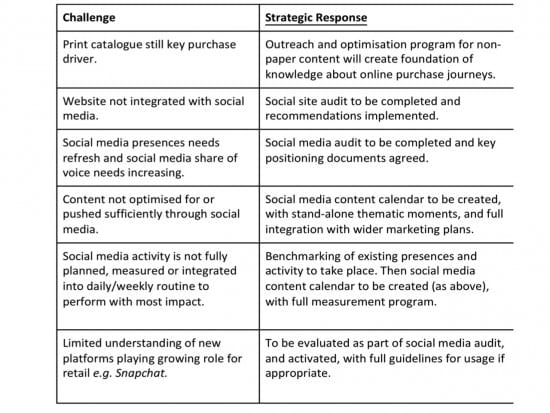Creating your social media strategy and tactical plan
Noun: Strategy / A plan of action designed to achieve a long-term or overall aim.
First, you need to understand what a strategy is, and isn’t it. A strategy should define the main aim of your social media presence and set the parameters for what it will deliver and how it will be delivered. It will be supported by a tactical plan that defines how the strategy will be delivered, including the channels, resource and budgets to achieve it.
Download our Free Resource – 10 common social media marketing mistakes
Avoid the pitfalls that limit engagement with your target audience by taking a look at our Free guide on some of the most common social media mistakes.
Access the
Tip – ensure your strategy is no more than 3-4 pages long. A strategy has to be concise and provide the governing principles that guide the plan.
1 - Building the strategy
Below is a summary of key content to include in your strategy document.
1.1 - Strategy statement
A short, concise summary of what the strategy is aiming to achieve, broken down into bullet points. Below is an example from a homewares retailer I worked with:
- We will undertake a full social media audit, benchmarking current positions, implement key improvements identified and develop content plans and styles to deliver consistent communications ongoing.
- We will increase engagement from existing customers and connections, and draw in new audiences - ultimately driving purchase through organic & paid activity.
- We will test and learn about the community and the brand in a social space, in order to shape the future growth of social media audiences and social driven purchase.
1.2 - Context analysis
Set-out where you are in your social journey and where the business needs to be, and the reasons for this.
For example, are you a global organization seeking to consolidate a fragmented approach to social media, or a startup looking to build a social presence from the ground up?
1.3 - Goals & Objectives
Goals define your high-level aims and objectives use SMART criteria to ensure each goal has a measurable set of criteria against which to evaluate progress.
I still use SMART criteria for objectives because they encourage you to think about the practicality of achieving each goal, rather than focusing on things that sound good but might not be feasible.
S = Specific in terms of what needs to be achieved
M = Measurable so that progress can be tracked and evaluated
A = Achievable so that your team has a realistic chance of success
R = Relevant to your business so it’s aligned with overall business goals
T = Timeframe within which the objective must be satisfied
Below are examples of high-level goals for your social media plan:
- Complete social media audit and implement actions arising from it
- Create and maintain a social media content calendar
- Begin regular social media activity, in line with strategy and calendar
- Create and work within a measurement framework
- Demonstrate the impact and ROI of social media to the wider business.
An example of a smart objective for goal #5 is:
We want to increase our followers on Twitter (Specific) to drive more organic social traffic to the website (Achievable/Relevant). We want to gain 1,000 new followers (Measurable) from our marketing by 31st January (Time based).
1.4 - Strategic challenges
Here you set out the business challenges for the social channel that need to be overcome, and the strategic activities that will enable this. Below is an example – I find using a tabular form helps to visualize this:

1.5 - Target audience
This frames who you want to reach via social networks. For this, you need to understand your core audience (personas, profiles, demographics etc.) and identify any new customer types that you want to attract based on your products/services. It can help to split this into three types of social follower:
- Loyal
Regular customers who are already connected to you via social media. You want to retain them and increase their purchases and engagement with your social profiles.
- Existing
Customer who have shopped with you before but aren’t regular shoppers and haven’t connected on social media. You want to nurture them, bringing them closer to you online and therefore increasing purchase rates.
- Potential
People who have never visited the website or purchased from you but who are regular online shoppers, and users of social media. You want to use social media to bring them into contact with the brand, and ultimately move them to purchase
1.6 - Review
Your strategy shouldn’t be set in stone; it needs to be flexible to respond to changing market conditions.
Include an explanation of the review process:
- Who will lead the review (business sponsor)?
- How often will the review take place?
- What data/insights will be used to inform the review?
- What will the outputs be?
- How will outputs be measured/monitored?
Some people include social media guidelines in the strategy but we don’t think this is the best approach. Guidelines are part of the tactical execution, providing a set of rules for the business to adhere to. It’s not a strategic activity, so this content sits best within the tactical plan, or as a separate document referenced by the plan.

1.7 – Related documents
Make sure you include links to all other documents that are relevant to your social media strategy so that anyone new joining the business can find them and get the full picture.
2 – Creating your social media plan
2.1 - Deliverables
This provides a summary of all activities that need to take place to support the implementation of the plan. For example:
- Social Media Audit (Word doc) - to be completed by <name>, including summaries of the following:
- Benchmarking of social media integration
- Benchmarking of Facebook profile
- Benchmarking of Twitter profile
- Review of the suitability of other platforms e.g. Pinterest, Youtube
- Recommendations of next steps for each platform/area
- Social media content calendar (Excel document) to be created, with stand-alone thematic moments, and full integration with wider marketing plans
- Measurement framework to be devised (Excel document)
- End of phase evaluation report to be completed (PPT plus full data in Excel).
2.2 - Channels + activities
Here you will spell out what you’ll be doing for each social network to satisfy the goals of your social strategy. Be sure to include all tactical elements and any related, process, people and tools.
Below is an example channel level plan for Twitter:
We will use our primary Twitter handle as both a customer service channel and a broadcast/interaction channel instead of having 2 separate handles. Twitter will be used to make us feel extremely accessible to consumers – real humans at the other end in real time (so we will initial conversations wherever possible). This will be beneficial in developing brand awareness and putting a real face to the products bought elsewhere.
Key actions:
- Housekeeping – follower clean up, including cross-referencing to email database using a tool such as FollowerWonk or SocialBro
- Following key influencers and thanking new followers personally (and doing this regularly)
- Tweeting at least x2 times a day (using a tool like Buffer to help schedule updates)
- RT’ing useful/relevant stuff (kudos by association)
- Sharing every blog post created twice a week (‘in case you missed it’)
- Important to highlight personal customer service i.e. signing off tweets, not just taking all issues offline/other channels
- Handling negative exceptions visibly to demonstrate that you take issues seriously but taking offline when appropriate
- Being innovative with content formats e.g. testing Q&As with your product experts on specific topics
- Twitter cards will be trialled around product launches or specific campaign pushes.
2.3 - Integration with other marketing
Note down how social will align with other marketing channels so that the people doing the work understand the wider picture. For example, for email marketing explain:
- How you’ll use social networks to promote newsletter content
- How you’ll use apps/widgets to drive email sign-up
- How you’ll use social engagement data to inform the email team what content is working well and for whom.
Don’t forget, it’s a two-way street, so also define how you need other marketing channels to support social. Again, taking email as the example:
- Our social network links will be included in the email footer
- Emails will include social sharing option which posts the browser version of the email
- We will work with the email team to explore how we feature popular social content in relevant emails.
2.4 – Timelines
This is the ‘T’ in the SMART objectives – ensuring each activity has a time frame stamped on it, so you can track progress.
Timelines are critical because they give you a yardstick against which to measure your ability to implement the strategy. Activities without deadlines tend to drift and are often seen by others as less important (if you don’t know when you need it by, it can’t be important can it!).
Note that some activities are recurring, such as posting the weekly newsletter to Facebook. For these simply state the frequency and target day of the week.
2.5 - Measurement
Start by defining the KPIs for your social strategy, which should break down into macro KPIs (for the whole strategy e.g. increase traffic from social media) and micro KPIs (channel specific e.g. increase RT rate on Twitter).
You should align your KPI expectations with the metrics that you can track for each social network so that they can easily be measured. Then sense check that your web analytics tools are configured correctly to capture all relevant data.
I recommend using campaign tracking parameters in all URLs you share via social. Using Google Analytics as the example, this means adding UTM parameters for at least medium, source and campaign.
Why?
You’ll be able to drill down into traffic from social and isolate specific elements of activity, such as individual links. I’ve used this for differentiating between different content formats, such as text vs. image vs. video updates for the same campaign. You can overlay ecommerce goals and conversion data to see what is adding the most value, and use the learning to fine tune your social marketing.
Include details of the reporting you’ll do to measure performance, and where these reports can be accessed.
Your thoughts, comments and personal experience
So this is step 2 in the Smart Insights 12 step series on social media strategy and planning.
Did you find it useful?
Do you think there are any gaps i.e. would you put anything else in a social media strategy or plan?
Please join in the discussion with comments and your own experience. Keep an eye out for next month’s article, “What competitor analysis should we do to inform our social media strategy?”.
If you missed the previous post, catch-up by reading "6 reasons why you need a social media strategy".

Thanks to
James Gurd for sharing his advice and opinions in this post. James Gurd is an experienced ecommerce and digital marketing consultant with more than 14 years’ B2C and B2B digital strategy experience. He is the Owner and lead consultant at
Digital Juggler. You can follow him on
Twitter or connect on
LinkedIn.





 Thanks to
Thanks to 


